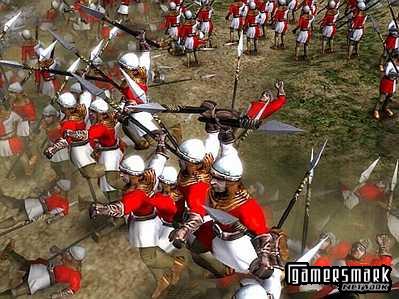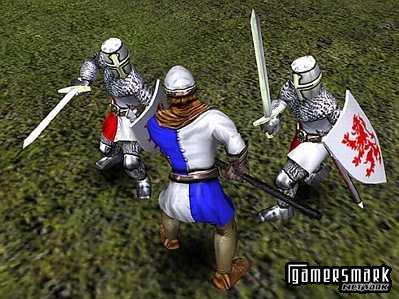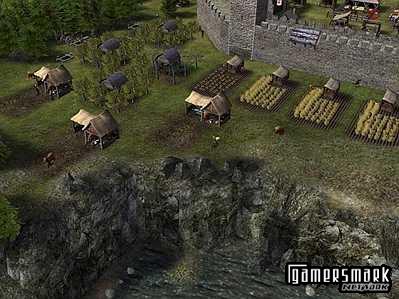Developer: Firefly Studios / Publisher: 2K Games || Overall: 6.0/10
Nowadays, it’s debatably hard to find a real time strategy (RTS) game that can compare to the classics. Games like StarCraft, Age of Empires II, the Command & Conquer series, and the Krush Kill n’ Destroy series (one of my personal favorites) really set the standard for me to judge other games in the genre against. Firefly Studios’ Stronghold 2 pales in comparison to the aforementioned, outright. While Stronghold 2 does have some interesting aspects to it, they are not executed as greatly as they could have been. While it can create a minute interest for the long-time RTS PC gamer, Stronghold 2 falls devastatingly short of being what it strives to be: a good RTS game.
The biggest thing about any RTS game is the actual strategy you use to thwart your enemies. There are two ways to play, either militaristically or economically. If you chose the military route, your castle will concentrate more on creating units to fight against your enemies. While you still have to keep your economy up, the main point of it is to fight. If you chose the economical route, you’re in for a more or less long game. You’ll focus on making your castle a bustling center of economic activity, creating enough food to feed your people with, as well as gathering resources to build up an army to attack or defend against invaders.
The kind of style you pick will affect the kind of game you play, whether it is in Campaign or Free Build. Campaign will take you through objectified missions where you will complete a mission given to you by your superior. How you get to that point is up to you, but the purpose of it is to get to that point. Unlike most RTS games, once you complete a mission, the next mission you undertake will use the same map and base you had just built, still being able to use what was created. During campaigns, you will always be able to see the whole map screen, being able to keep an eye on neighboring estates and castles. In the Free Build mode, you’re able to just create your castle and watch it bloom. Or you can undertake the task of going head-to-head with a computer player. There is also a Multiplayer mode and the ability to play user-created maps made by the in-game map editor.
Castle towns in Stronghold 2 revolve around three important buildings: the Stockpile, the Granary, and the Lord’s Kitchen. The Stockpile holds all the materials your peasants gather from the surrounding environment, and bring it into the storehouse until it is used. There are many types of resources that can be gathered, such as wood, pitch, stone, iron, etc. The most vital resources you will use (mainly to build buildings and castle parts) will be wood and stone. Other resources are used to create weaponry or other different objects. The Granary stores all the food that your peasants will harvest, including apples, meat, dairy, and wheat. Your granary can hold an infinite amount of food, and will also control how much food you distribute to your people. The Lord’s Kitchen is the storage house for the finer foods of back in the day, such as pigs, eel, geese, wine/grapes, and vegetables. Using the Lord’s Kitchen, you can hold feasts in your name, thus increasing your honor. To gather all the different types of resources, you have to build different buildings to which your peasants will automatically go work in as soon as you build them. Whenever you run out of jobless peasants, you can build more housing space (called a Hovel) for more people to live in and wait for new jobs to be undertaken.
How well your town does depends on the two important factors of Popularity and Honor. Popularity is basically how much your peasants like you, and if there are any displeasing or pleasing things happening in the way you’re keeping your town going, it will be shown. To achieve more popularity, you can do things like increase rations or not tax. The maximum amount of popularity you can have is 100, so if you’re at 100 and there’s no loss of popularity, it’d be to your benefit to reduce rations to normal, so that a larger stockpile can be gathered in your Granary. Things that can damage your popularity, making people leave in eventuality, would be if you taxed them (more tax will have more popularity loss) or left piles of “gong” around without having someone clean them up. Another aspect is “honor” in which you gain a certain amount of to use mostly for military needs, and to “buy” more plots of land from your king to use for yourself and expand your ventures. A very good way to increase your honor is to hold feasts, using the food held in the Lord’s Kitchen. There are a few other ways to increase your honor, such as attending church, getting married (to a woman, if you’re wondering), holding a jousting tournament and holding medieval dances to name most of them. The “industries” that create particular types of resources may be turned off fairly easily, should the need ever arise, but there is no option to stop just one building from doing what it is doing, resorting to having to destroy the building to stop it.
Laying down this framework, just like every other RTS game, you build a mass of soldiers and spend a good deal of time trying to take over the whole map.
Experienced RTS gamers may find a few very annoying parts to the game, to say the least. Probably the most apparent thing is that you can’t control your peasants at all. They are controlled by the computer at all times, and even if they were being attacked by a wolf, you can’t tell them to run away. There’s also a non-traditional way of seeing how many resources you have. Other than the ever-present information about your Gold, Honor and Popularity, you have to click on your Stockpile to see how much of each resource you have. If that wasn’t enough already, the most important part of an RTS game, combat, is slow. Half of the problem would have been remedied if your units didn’t move equally as slow as well. So if you’ve got a wolf problem or an invading army already attacking a building of yours, chances are a few bad things are going to happen before you have a chance to do anything about them. Also, it will take some memorizing (and frequent reference to the instruction manual) to use all the buildings, as there are a lot of buildings whose names don’t clearly reference to what they actually do. It may be hard to figure out that the Fletcher’s Workshop is for making bows and arrows or the Hop Farm is used to make ale. Unless you just happened by this information in your ventures through education beforehand, it might be kind of hard for you to remember which building does what.
The graphics utilized in the game are not very pleasing overall. While I did enjoy how the environment looked like (mostly because of the trees), I came to the realization that the graphics were not that great, especially when I zoomed in closer to objects I was looking at. In the game there are buildings, humans, and animals, all of which look lackluster unless you zoom in. Though, there are many different views to look at your castle and land in full 3D. The sound is about average quality. The best part about the sound would be the music and sound effects. The voice-overs included in the game are some of the most horrible stuff I’ve ever heard. Everyone in the game sounds like an idiot, to be frank. I hate to hear the stereotypically dumb peasants who like to say “liege” when referring to you, and hear about how “the rations are not good, but they’re not bad and that’s about all there is to say about that.” But, you can learn to live with it if you try to restrain in ever clicking on your peasants to see their status.
The two big complaints I have about this game stop it from attaining a decent score. First is when you start up the game; it takes forever to load. You’ll be sitting there for what seems like ten minutes, wondering why it takes so long to load a menu screen, only to see that it’s been loading a five minute movie, which you have to press escape to not see and go to the menu screen. The other comes with the atrociously low frame rate your game will inevitably have as you build more buildings and create more living space for peasants. The low frame rate makes the game very unpleasing to play, nor is it avoidable, even if you have a computer that far outweighs the minimum (and recommended) requirements of a 2.0Ghz processor, 512mb RAM, and 64mb graphics card. The computer I use actually is the minimum and recommended settings combined, and I still had problems with the long loading and slow frame rates. Though there is an update that increases the version number to v1.1 (currently), these vital issues are not fixed.
I really wanted to like Stronghold 2, but the unfortunate result is a lackluster RTS that will be easily forgotten. If the developer is able to fix the game’s major flaws and tweak the game play (it wouldn’t hurt if the graphics were made just a little bit better) in a possible second sequel, then it would be worth another look, but in its current state, Stronghold 2 is a game any self-respecting RTS gamer should stay away from.



